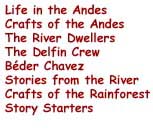

Monday, November 20, 2000
The Upper Samiria
Field research can be very tedious and sometimes even boring. A researcher can spend hours and even days waiting for the target species to appear. We have actually been very lucky. While there are stretches of the rivers and lakes where we don't find any dolphins, we never have gone an entire day without seeing them. Getting good pictures is another thing however. We have to be very patient and persistent. Both species of dolphins come to the surface only briefly to breathe. What is maddening is that unlike marine dolphins—where if you spot one you can predict where it will appear next —botos and tucuxi appear to swim around in random patterns. We often just catch a glimpse of one before it disappears back into the water.
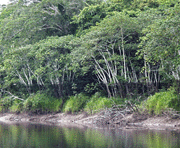
![]() We
took the skiff up a very small tributary of the Rio Samiria yesterday morning
to explore and look for wildlife. The captain motored up the channel for about
an hour and then we let the current carry us silently back downstream. It
is a good thing we could float back down because the rope that starts the
motor broke. There is rarely a dull moment around here. The Captain was able
to fix the motor. Thankfully he is very knowledgeable about mechanical things
as well as the river. Traveling up river we are again struck by the high water
markings on the trees. They are a good 20 feet above the current water level.
We
took the skiff up a very small tributary of the Rio Samiria yesterday morning
to explore and look for wildlife. The captain motored up the channel for about
an hour and then we let the current carry us silently back downstream. It
is a good thing we could float back down because the rope that starts the
motor broke. There is rarely a dull moment around here. The Captain was able
to fix the motor. Thankfully he is very knowledgeable about mechanical things
as well as the river. Traveling up river we are again struck by the high water
markings on the trees. They are a good 20 feet above the current water level.
The morning mist was still rising from the river when we rounded the last curve and the Mirón Lento came into view. Lester had not yet taken down the netting from the "Mosquito Palace." Shelly was just waking up and we could see her silhouette as she sat up and stretched through the gaze of the net. Behind her was the wall of verdant jungle. Howlers "howled" from the bank. A flock of hoatzin was roosting in a nearby tree. Could there be anywhere in the world more exotic or more isolated than this place?
The captain has a remarkable ability to spot animals in the forest. This entire trip he has pointed out animals high in the trees or camouflaged along the banks. His best so far though was when he spotted Monk Saki monkeys high in the forest canopy. They are black with long shaggy fur and very long tails. They live in the middle and upper levels of the forest and at night they sleep on large branches in the upper canopy.
Among the birds we see almost every day are the: Anhinga, White necked Heron, Great Egret, Snowy Egret, Capped Heron, Black-crowned Night-Heron, Rufescent Tiger Heron, Horned Screamer, Black Vultures, Black-collared Hawk, Black Hawk-eagle, Osprey, Yellow-headed Caracara, Wattled Jacana, Parrots, Blue-and-Yellow Macaw, the rare Hoatzin—the list goes on and on.
As we move up the river we have a chance of spotting manatees. Although they exist here, they are very rare and shy. The meat is considered a delicacy and because they are so slow moving, they are easy to hunt. This August a large one came floating down past Station 2. It had been caught in a trap but the rangers thought that it had probably gotten away from the poachers and died later from its wounds.
Puesto Vigilancia 3 —Ranger Station 3
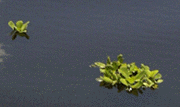 We
have crossed over to 05 degrees south latitude! Here the Rio Samiria narrows
to no more than 50 to 75 meters across. Huama —water lettuce—grows
nears the edges of the river. Both the turtles and the manatees feed on huama.
Enzo was about to taste it until Horacio told him that the locals use it as
a laxative. We certainly don't need that on this trip.
We
have crossed over to 05 degrees south latitude! Here the Rio Samiria narrows
to no more than 50 to 75 meters across. Huama —water lettuce—grows
nears the edges of the river. Both the turtles and the manatees feed on huama.
Enzo was about to taste it until Horacio told him that the locals use it as
a laxative. We certainly don't need that on this trip.
The rangers here also harvest turtle eggs for incubation and release. In addition to hatching the yellow side-necked species, they also protect the larger, more rare and endangered "Podocnemis expansa" or Charapa. These grow to be close to 1 meter. They are more widely hunted because of their large size and greater amount of meat.
As we have mentioned before, the rangers in the Reserve have minimal supplies. They also have no weapons. Last year we wrote of the murder of three rangers at Station 1 by poachers. The rangers had confiscated the poachers' illegal fishing net. Ever since then, all the Rangers have been concerned. Their job is to protect the animals in the Reserve, yet they have no way to defend themselves against poachers.
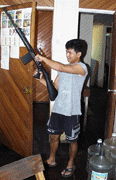
![]() The
rangers here have carved themselves what looks to be a cross between an M16
and Russian-made rifle out of wood and painted it black. It looks very authentic.
They take this with them when they go on patrol.
The
rangers here have carved themselves what looks to be a cross between an M16
and Russian-made rifle out of wood and painted it black. It looks very authentic.
They take this with them when they go on patrol.
Pirañha (Serrasalmus sp.)
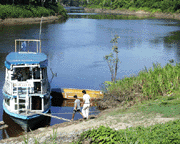 We
were all looking forward to a swim when we arrived at the ranger station yesterday
afternoon. It had been a long day of counting dolphins. We can only swim now
near the stations because caiman are everywhere, except near the stations
where the rangers' dogs scare them away. The rangers warned us that there
were many pirañhas around the dock, but that as long as none of us
had any open, bleeding wounds, we would be fine. Some of us were game to swim
just for the novelty of swimming with pirañha.
We
were all looking forward to a swim when we arrived at the ranger station yesterday
afternoon. It had been a long day of counting dolphins. We can only swim now
near the stations because caiman are everywhere, except near the stations
where the rangers' dogs scare them away. The rangers warned us that there
were many pirañhas around the dock, but that as long as none of us
had any open, bleeding wounds, we would be fine. Some of us were game to swim
just for the novelty of swimming with pirañha.
Before jumping in Shelly took some small pieces of wood from the dock and sprinkled them in the water. Immediately dozens of fish came to the surface to "feed" on the chips. Seeing so many hungry mouths made us decide not to swim. Instead, we leaned over the side of the dock, daring one another to test the water with our fingers and toes. You'd have thought we were a bunch of seven-year-olds by the way we giggled and dared one another. Geoff was the biggest dare devil of all, sticking his entire hand in the water. (He still has it!)
Horacio gave us some chunks of meat to tie to a piece of string so that we could try and catch a pirañha. All we caught, though, was a catfish that we let go.
This morning we are heading to Station 4. Nobody on the boat has been there. Moreover, nobody on this boat knows exactly how far up-river the station is. It could be a three-hour ride or it could take all day. We have no accurate maps. Even the rangers themselves disagree about how far the distance is. We heard on the radio this morning that the president of Peru, Fujimori has gone to Japan and is not coming back because of the recent, on-going scandal in the government. There is a great deal of speculation on the boat and the radio as to who will assume control of the government now that he is gone. While it means a great deal to the people of Peru, we wonder if it made the news in the United States. You may want to check CNN, the New York Times or another large-city newspaper, or news websites for updates.
Things we are tired of:
Things we are not tired of:



